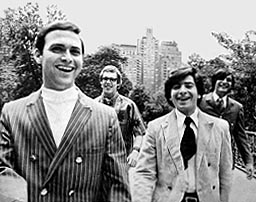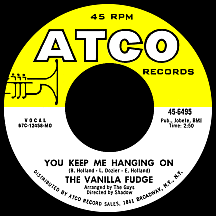VANILLA FUDGE
You Keep Me Hanging On
Mind-expanded Motown! Pop and soul music transformed into psychedelia above, below and beyond what the original composers intended! This band of Jersey guys specialized in reshaping familiar '60s hits into grandiose rock productions. In 1965, organist Mark Stein, bassist Tim Bogert and drummer Joey Brennan broke away from Rick and the Showmen, a New York area group they'd played with briefly, to form The Pigeons, later adding guitarist Vince Martell in a concerted effort to bring their favorite R&B songs into a rock nightclub environment. They found work in clubs up and down the east coast throughout most of '66 and occasionally backed touring vocal acts (one being girl group The Shangri-Las).
Stein was the most experienced of the four, having made a record for a small label when he was 15, a doo wop group number called "Come Back to My Heart" as Mark Stevens and the Charmers that, all things considered, was a strong track; with a little luck it could have been a hit, but was perhaps a little behind the times when it came out in 1962. He cut his teeth playing guitar during his childhood but later found he had a knack for creatively manipulating a keyboard. Bogert, five years Stein's senior, messed around with piano, clarinet and sax (playing the latter in a local surf combo) before permanently taking up bass. As the band's experience widened, Brennan drifted away and was replaced around the end of 1966 by Brooklyn-born Carmine Appice, one serious percussion man who'd grown up emulating the greats of the big band era.
The Pigeons plied their brand of rocking soul in various clubs (Wilson Pickett, Otis Redding and the stars of Motown among the artists whose work they often performed), finding steady work on Long Island where The Vagrants, having the same predisposition for R&B, had made some local impact; the bands became friends and friendly rivals. The Pigeons were particularly impressed with The Young Rascals, who in early '66 had amped up The Olympics' soul hit of a year earlier, "Good Lovin'," and topped the charts. With Felix Cavaliere's organ workouts at the core of Rascals recordings, it encouraged Stein, Bogert and company to try the same approach, building each song around Stein's classically-inspired keyboard intros and musical bridges, resulting in much longer finished takes than were typical at the time. Some club owners and managers weren't impressed with what was, to their ears, the destruction of perfectly good music; bookings were suddenly harder to come by. In some cases, the band was thrown out into the street midway through a set.
Phil Basile, owner of Long Island's Action House, differed in his opinion about the "trippy" sounds of the Pigeons and other bands experimenting in similar ways. The Action House was a hot spot for what would soon be commonly called psychedelic groups; the Vagrants and The Illusion, another up-and-coming Long Island outfit, often headlined there. Even the Rascals played the club in '66, a major event of sorts for the star-struck Pigeons. Basile had connections in New York and managed to get Shadow Morton, a former producer for Red Bird Records (working independently and on the verge of success with Janis Ian's brilliant breakthrough single "Society's Child"), to stop by and check them out. Morton's reaction was "Come on, what is that?" but felt their spaced-out rendition of The Supremes' recent number one smash "You Keep Me Hanging On" had potential, so he set up a recording session for them.

Morton pitched the Pigeons to Atlantic Records chief Ahmet Ertegun, who was in the process of expanding the company's position in the industry by adding harder rock acts to the label's already impressive roster. Just the kind of act he was looking for, he signed them to the label's Atco imprint. "Pigeons" seemed dated as a name; Atco had recently signed British rockers Cream and suggested they come up with a similar moniker. The guys chose The Vanilla Fudge in reference to those yummy Drumstick ice cream cones; only later did people hypothesize on the coincidence of a white rock group with such a name doing black music remakes, though band members have all insisted it never occurred to them. A seven minute version of "Hanging On" (as part of an even lengthier piece called "Illusions of My Childhood"), cut for the Vanilla Fudge debut album, was edited to a two minute and 50 second single and hit the charts for several weeks that summer. The flip side, "Take Me For a Little While," written by singer-guitarist Trade Martin, had been a minor hit for Evie Sands in the summer of 1965. By the time the album was released, "The" had been excised from the group's name and, despite a slow start, the band traded in many small club appearances for larger venues.
In early 1968 they released their second single, "Where is My Mind," an original Mark Stein song, backed with an oddly low-key cover of Burt Bacharach and Hal David's "The Look of Love," a big hit several months earlier for Dusty Springfield that was currently in contention for the Oscar for Best Song. No time was wasted getting the second album out; The Beat Goes On was risky and, it turns out, ahead of its time, as it layered the Sonny and Cher song with interpretations of the works of Mozart, Cole Porter, Leiber and Stoller, The Beatles and Beethoven in addition to sound bites of mid-20th century world leaders; before long scores of bands were releasing albums using similar tactics.
Just as the band's third long-play, Renaissance, was hitting store shelves in the summer of '68, the label rereleased "You Keep Me Hanging On" with a different B side (putting the apostrophe in "Hangin'," paralleling the Supremes' original) and this time it took off, landing back on the charts in July and reaching the top ten at the end of August. The initial game plan of psychedelicizing established pop and soul hits appeared to be what worked for the band. While Brit counterparts Cream and other bands were on a blues revival mission, giving a large percentage of youthful rock fans their first exposure to those songs, Vanilla Fudge opted to remake songs that everyone knew: the big hits of more recent years, recycled in wildly original and elaborate ways.
"Take Me For a Little While" was released separately as a follow-up and made the top 40. The Fudge released two more albums (five total in a little over two years!), the last two post-Shadow Morton productions, and hit the charts with their takes on Donovan's "Season of the Witch," Jr. Walker and the All Stars' "Shotgun" and the ethereal Nancy Sinatra-Lee Hazlewood hit "Some Velvet Morning" taken even further out. The group's end coincided with the start of the new decade; stressful relationships among band members, and the tendency for other '60s psych acts to divide and diversify, accelerated the inevitable. There was one final show at the Action House in March 1970, after which Bogert and Appice reappeared on Atco as Cactus. Later Tim and Carmine joined Jeff Beck (who they knew from the early Action House days when The Yardbirds played there) for the album Beck, Bogert and Appice. Starting in the 1980s, original Vanilla Fudge members (not always all four at the same time) have done reunion tours and recorded a few albums, working through differences for the sake of art, money or whatever it took to rekindle their heyday as one of the most innovative bands of the psychedelic era.


